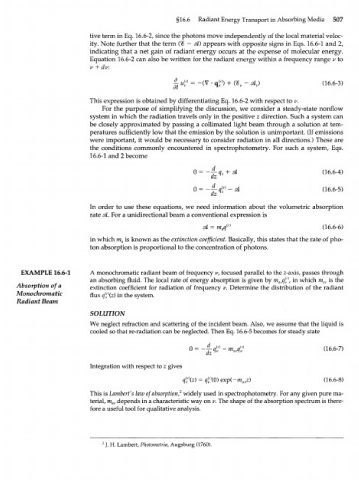Page 527 - Bird R.B. Transport phenomena
P. 527
§16.6 Radiant Energy Transport in Absorbing Media 507
tive term in Eq. 16.6-2, since the photons move independently of the local material veloc-
ity. Note further that the term {% - si) appears with opposite signs in Eqs. 16.6-1 and 2,
indicating that a net gain of radiant energy occurs at the expense of molecular energy.
Equation 16.6-2 can also be written for the radiant energy within a frequency range v to
v + dv\
(
{
— и ? = -(V • qj°) + {% - si ) (16.6-3)
v v
This expression is obtained by differentiating Eq. 16.6-2 with respect to v.
For the purpose of simplifying the discussion, we consider a steady-state nonflow
system in which the radiation travels only in the positive z direction. Such a system can
be closely approximated by passing a collimated light beam through a solution at tem-
peratures sufficiently low that the emission by the solution is unimportant. (If emissions
were important, it would be necessary to consider radiation in all directions.) These are
the conditions commonly encountered in spectrophotometry. For such a system, Eqs.
16.6-1 and 2 become
0=~q + s& (16.6-4)
z
П u (r) (16.6-5)
0 = —j-qz ~~ '
In order to use these equations, we need information about the volumetric absorption
rate si. For a unidirectional beam a conventional expression is
si = m q (r) (16.6-6)
a
in which m is known as the extinction coefficient. Basically, this states that the rate of pho-
a
ton absorption is proportional to the concentration of photons.
EXAMPLE 16.6-1 A monochromatic radiant beam of frequency v, focused parallel to the z-axis, passes through
an absorbing fluid. The local rate of energy absorption is given by m j$, in which m is the
av
a
Absorption of a extinction coefficient for radiation of frequency v. Determine the distribution of the radiant
Monochromatic flux q^(z) in the system.
Radiant Beam
SOLUTION
We neglect refraction and scattering of the incident beam. Also, we assume that the liquid is
cooled so that re-radiation can be neglected. Then Eq. 16.6-5 becomes for steady state
d (16.6-7)
~d~z l
Integration with respect to z gives
(16.6-8)
2
This is Lambert's law of absorption, widely used in spectrophotometry. For any given pure ma-
terial, m depends in a characteristic way on v. The shape of the absorption spectrum is there-
av
fore a useful tool for qualitative analysis.
J. H. Lambert, Photometria, Augsburg (1760).
2

